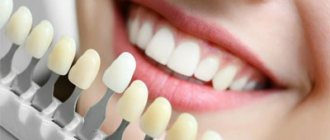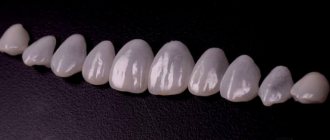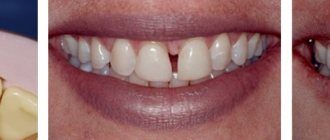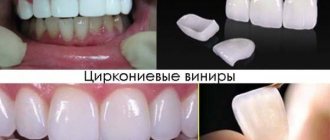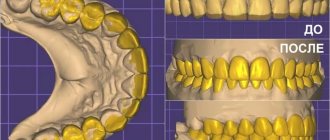Veneers are microprostheses that are widely used in aesthetic dentistry and allow you to achieve the ideal appearance of the anterior group of teeth. They are used in cases where existing defects cannot be corrected by other methods or the result is needed in a short time. Unlike crowns, they do not completely cover the teeth, but only their front part and the cutting edge. Most often, veneers are installed on the 8 lower and 10 upper teeth. Is it necessary to install veneers, their pros and cons - this is discussed in our article.
What are veneers for?
In what cases are veneers placed on teeth? Installation of veneers is recommended for:
- darkening of the enamel that does not disappear after the whitening procedure;
- cracks and chips;
- non-carious enamel damage (fluorosis, tetracycline staining);
- irregularities in shape (uneven teeth) and position of teeth.
Restorations with veneers can be direct or indirect. The first ones are carried out directly in the patient’s mouth, and indirect ones - in a laboratory setting. Indirect ones allow you to achieve higher aesthetic results; teeth after such restorations look more natural, and veneers made of zirconium, ceramics or composite materials are used for their implementation.
Myths about veneers
13.03.2018
At initial consultations, as well as when presenting a treatment plan, Atribeaute Clinique dentists are often faced with the fact that patients have misconceptions about certain dental procedures. Most often, this concerns the manufacture of veneers. So, today we’ll talk about myths regarding orthopedic dentistry, namely about indirect, ceramic veneers. So, the most common myths about veneers:
1. To install veneers, you will have to cut down your own teeth
This is perhaps the most common myth we encounter when discussing a treatment plan. What is it based on? The thing is that before the use of modern ceramic materials, metal-ceramic structures were popular in dentistry. Ceramics at that time were not perfect (fragile), and they had to be strengthened with a metal frame. But at the same time, a certain volume of ceramics was needed to cover the metal. That is why it was necessary to carry out significant preparation of the tooth tissue, often even depulping the teeth (removing the nerve). But that is a thing of the past.
Modern materials are so durable and aesthetic that minimal treatment of tooth tissue is required. Often, it affects only the limits of the enamel. If restorations have been previously performed on the teeth, then the orthopedic dentist works entirely within the limits of the filling material.
Durability is due to the fact that modern dental laboratories use the so-called E-MAX pressed ceramics, which can be compared to metal in strength, while maintaining unsurpassed aesthetic characteristics.
Comparison of the degree of dental treatment for metal-ceramics and pressed ceramics in the photo:
For metal-ceramic structures:
For E-MAX ceramics:
2. All nerves in the teeth will have to be removed
The reason for this myth is related to the degree of dental treatment, as indicated above. And again, when making metal-free structures, there is no need for devitalization of teeth (removal of nerves).
3. Veneers look unnatural and change the color of the gums.
And again, the reason for the emergence of this myth was the early period of dentistry, when only metal-ceramic structures were made. The color, due to the presence of metal in the structure of the structure, was unnaturally opalescent (not transparent enough). And the change in gum color was associated with direct contact of the oxidized metal with the gum.
Properly made veneers, performed by a good technician, cannot be distinguished from natural tooth tissue, and the gum remains unchanged.
4. Be sure to put veneers on all teeth
Of course, if you want to completely transform your smile or restore the height of your bite, you can do a total job. We, at the Atribeaute Clinique aesthetic dentistry department, have extensive experience in this field and a huge number of satisfied patients. But at the same time, if there is a need to make a single veneer, everything is feasible! An orthopedic dentist in a well-coordinated tandem with a dental technician performs such complex work. Here is an example of one such work:
5. Veneers will change color sooner or later.
Unlike restorations made with composites, which must be periodically polished in order to restore shine and, as a result, brightness to the teeth; Teeth covered with veneers do not require this type of procedure. This is due to the fact that the structure of the composite is more porous and is more susceptible to the absorption of certain pigments. Veneers have an absolutely smooth and shiny surface, so they are not subject to discolouration. But this does not mean that they do not require individual and professional care. This will be discussed below.
6. Veneers constantly chip and can come off at the most inopportune moment.
This statement is most likely based on the unsuccessful experiences of people familiar to the patient. Indeed, such a phenomenon as chipping of a veneer or its loss occurs quite often. But not our patients!!! It's all about following the indications for making veneers. The most important criterion is the question: does the bite allow the veneers to be fixed? That is why, in order to draw up a treatment plan, all our patients undergo a consultation with an orthodontist, who gives the go-ahead for the installation of veneers. If a clinical case requires orthodontic intervention, the bite is first corrected, and only after that, the veneers are fixed. In this case, the above problems can be avoided.
7. I’ll get veneers and forget about my teeth for a long time!
Unfortunately, yes – it’s a myth. You shouldn’t forget about your teeth, even after installing veneers! In addition to daily individual care, using a toothbrush, toothpaste, dental floss and brush, visits to the dentist once every 6 months are mandatory for professional care and examination by an orthopedic dentist. When asked what can happen to veneers and crowns made from artificial materials, we answer that in the absence of proper care, the gums can become inflamed and gingivitis can develop, and in later stages, periodontitis, which can lead to tooth loss. Also, without maintaining hygiene at the proper level, caries can develop at the border of the veneer and tooth tissue. Which again entails the need for repeated treatment procedures. Prevention is better than cure.
These were perhaps the most common myths associated with veneers! To avoid false judgments about modern dental technologies, we recommend asking all your questions to a dentist during a consultation, who will be happy to shed light on a topic that is relevant to you and select an individual treatment method.
Does it hurt to put veneers on teeth?
Veneers are micro-prosthetic onlays, during the installation of which nerves are not removed and soft tissues are not damaged. Before installing them, a layer no more than 1.2 mm thick is removed from the tooth, and the procedure itself is preceded by anesthesia, which guarantees a complete absence of unpleasant sensations. The time required to prepare the tooth is about half an hour.
The pads do not cause discomfort when worn. After just a few days, the patient perceives the veneers as part of the teeth. The changes will only be aesthetic and for the better.
Tips for choosing veneers
Anton Konstantinovich Malygin, an orthopedic dentist at the ORIS clinic, shared recommendations for selecting veneers:
“We recommend that patients pay attention to ceramic veneers created in a special laboratory. They have much higher precision compared to composite veneers, and also meet all aesthetic requirements. Still, veneers are an aesthetic correction of a smile. You should not expect that they will correct complex defects in the position of the teeth. They are designed for easy correction. Their main task is color correction. With the help of veneers, you can radically change the shade of your teeth while leaving them almost intact.
Don’t forget that the thinner the veneers (the thinner version is called lumineers), the more light they let through. This means that the color of natural enamel may be too dark to be seen through the thinnest scales. That is why the determination of the desired color and type of construction is discussed with the patient at the very beginning. Veneers really transform the smile and do not affect the remaining parts of the tooth, meaning that therapeutic and endodontic treatment can be carried out unhindered in the future.”
Dental veneers: pros and cons
Installation of veneers is one of the most popular methods of aesthetic dentistry, preferred by many patients. We will look at the main pros and cons of dental veneers, which will help you assess the risks and draw the right conclusions.
Advantages of veneers:
- Long service life. Varies depending on the quality of materials and technologies used and can reach 10 years.
- Resistance to staining. This is typical for ceramic veneers, which are highly resistant to all coloring substances without exception. The appearance of ceramic veneers remains unchanged throughout their entire service life.
- Natural look. Microprostheses are selected in accordance with the color of the enamel of natural teeth, so they look as natural as possible.
- Quick installation. Veneers will take a maximum of one week to complete, although they usually take much less time.
- Simple procedure. Unlike crowns, much less tooth tissue is removed, so the procedure takes less time and requires less effort.
Disadvantages of veneers:
- Strength. Veneers are considered to be quite wear-resistant structures; however, when using them, you should avoid eating too hard food and be careful when practicing martial arts (boxing, wrestling, etc.).
- Need for replacement. At the end of their service life (usually about 10 years), veneers must be replaced.
- Difficult to select for teeth with dark shades. Ceramic veneers are transparent, so they cannot correct teeth that are too dark.
- Tooth preparation. To install veneers, a layer of dental tissue is removed - this is a painless procedure, which is more gentle than when installing crowns, but, nevertheless, this is what worries patients most often.
- Price. Microprostheses are quite expensive products, the price of which is higher than that of crowns. Why are veneers so expensive? The determining factors in this case are the technologies and materials used. The most expensive are ceramic veneers (Lumineers).
Alternative to porcelain veneers
According to dental orthopedic doctor Hamlet Artushevich Barakazyan, there are other types of veneers made from other materials.
Veneers can be made of different materials, for example, there are ceramic veneers, composite veneers, as well as composites and lumineers. The choice of manufacturing material depends on the individual characteristics of the patient, his goals and budget.
Porcelain veneers retain the original color, are highly durable and identical to the color of the enamel. Porcelain onlays are difficult to distinguish from normal, healthy human teeth. They are made in two ways: the first is layer-by-layer application of porcelain and heat treatment of the product; the second is production by injection molding using pressure and high temperature.
Zirconium dioxide onlays are manufactured using high-precision CAD/CAM technologies to produce a base - a zirconium frame, which is cut using automated equipment by milling. This method allows you to completely eliminate errors caused by the human factor. Next, these veneers are produced by applying porcelain paste to a zirconium frame under high temperature. The quality of such veneers is similar to products made from pressed porcelain, but they are significantly superior in terms of strength to products made without the impact of a press.
Lumineers are the only type of microprosthesis of this kind that uses gentle preparation of the tooth enamel - roughly speaking, practically nothing is ground down. These veneers are thinner than others - one fifth of a millimeter, however, due to the fact that such overlays are ultra-thin, their service life is slightly shorter than other veneers.
Types of veneers
For the manufacture of veneers, two types of materials are used, based on which the following types of products are distinguished:
- Ceramic. In turn, they are divided into porcelain and zirconium. The latter uses zirconium to make the frame, but the veneers themselves are also made of porcelain. They are more reliable than conventional pressed ones, but have less transparency due to the dense frame. The material for making veneers should be selected based on the color of the enamel of natural teeth. For transparent enamel, porcelain microprostheses are more suitable.
- Composite. Veneers, the manufacture of which can even be done by a general practitioner, since the entire process is carried out directly in the patient’s mouth. Therefore, they are often compared to conventional fillings. To produce high-quality composite veneers, you will need a well-equipped laboratory.
In what cases are veneers the right choice?
Veneers can disguise the most common visual imperfections that spoil a smile:
- Darkened, exfoliated fillings installed on the front of the tooth;
- Yellow or gray color of tooth enamel;
- Single crooked or rotated teeth, provided that the bite is correct and the dentition is generally straight;
- Teeth of irregular shape, with structural anomalies;
- Chips and abrasions on teeth;
- Large gaps between teeth.
Most often during consultations, patients are interested in whether it is possible to put veneers on filled teeth and whether veneers are placed on “dead” teeth. We answer: yes, onlays can be installed on filled and pulpless teeth. But provided that enough tooth enamel is preserved on them, since ceramic and composite onlays do not hold up as well on dentin. If there is not enough tooth enamel, an experienced doctor will recommend installing a crown.
Contraindications for installing veneers
The following contraindications exist for installing veneers:
- high tooth wear (especially in older people);
- bruxism (the habit of grinding teeth during night sleep);
- thin tooth enamel;
- presence of carious lesions;
- large chipped teeth;
- presence of large fillings;
- soft tissue lesions (gingivitis, periodontal disease, etc.);
- loss of the sixth and seventh chewing teeth.
Should I get veneers? Is there any reason to worry that their installation will harm you? The danger of veneers, which is rumored in certain circles of patients, is nothing more than a myth. We are talking about possible damage to healthy teeth when preparing them for the installation of veneers. But thanks to the advent of new ultra-thin veneers, today it is only necessary to prepare the enamel by 0.3-0.5 mm, and the tooth remains alive (crowns are installed on “dead” teeth).
Types of veneers
In aesthetic dentistry, several types of dental onlays are used, which differ in materials and installation methods. Depending on how veneers are made, they are divided into two main types - direct and indirect. This does not mean the shape of the plates, but the installation method.
Direct veneers are “made” directly in the patient’s mouth during an appointment. Indirect ones are made by a dental technician after preliminary preparation. Veneers are also classified by type of material - ceramic and composite. Ceramic ones are more beautiful, stronger, more durable and more expensive. Classic ceramic onlays are made from pressed ceramics, which are placed on a special frame and fired in a kiln. The thickness of such veneers along the main surface is 0.3-0.5 mm. Toward the cutting edge they thicken to 1 mm. Refractory (frameless) ceramic veneers are made from feldspathic ceramics, which are applied in layers. This is a more expensive type of overlay. The high price is explained by the fact that they are more difficult to manufacture and install than classic ones. Only an experienced orthopedic dentist can perform high-quality installation of veneers. If there are no critical shaped flaws on the teeth, such veneers can be placed without grinding the teeth.
Veneers can also be made from filling materials. They are much cheaper than ceramic ones, but they are also significantly inferior in service life. There are two types:
- In the form of overlays for teeth. They are made by a dental technician and are similar to classic ceramic ones.
- Composite. They are made by a doctor right in his office.
Patient reviews of composite veneers vary, but in most cases the negative ones are associated with poor-quality installation.
Is it worth getting veneers?
The answer of a doctor who is faced with the question of whether it is worth putting veneers on teeth is always obvious. Increased sensitivity of teeth, significant damage to the enamel, a large number of fillings on the front teeth - all this is a good reason to carry out restoration using ceramic veneers. If we are talking only about aesthetics, then the final decision must be made by the patient himself. In our opinion, this method of restoration has enough advantages and we tried to describe them as fully as possible. The only and most significant disadvantage can be considered the irreversibility of the procedure, but beauty, as we know, requires sacrifice.
Making veneers and installing them is a jewelry and creative work. Do not forget that the thickness of the microprosthesis does not exceed 0.6 mm (for lumineers - up to 0.1 mm), so your ideal smile will be guaranteed not only by advanced technologies and high-quality materials, but also by the professionalism of orthopedists and therapists. You can count on all this at Amel Dental - the only dental clinic in our country that is accredited by the Global Clinic Rating and is among the 200 best clinics in the world providing dental services.
Which veneers are best to choose?
If you compare photos of teeth with veneers before and after their installation, the visual effect will certainly be impressive. However, it is difficult to understand at first glance what material they are made of. Indeed, immediately after installation, both ceramic and composite veneers look great. Because of this, it may be tempting to opt for cheaper composite overlays. If the budget is limited, this choice is justified. But you need to understand that the service life of composite veneers is short - from 4 to 7 years. Ceramic plates last more than 10 years.
Price is not the only selection criterion. The type of defect that you plan to correct with veneers matters. For example, if you only need to “whiten” your smile, lumineers are a good option. There is no need to prepare teeth for them and they look as natural as possible. But, if the problem is a shape defect, thin lumineers will not be able to hide it.
Which veneers to choose should be decided together with your doctor after a detailed diagnosis and determination of all the nuances.
Thin plates for front teeth
Veneers are thin overlays, the thickness of which is 0.5 mm. They are used to restore the outer surface of teeth. The technology of using veneers itself was invented in the 30s of the last century by the American doctor Charles Pincus.
At that time, veneers were part of the costume of Hollywood stars. In order for the actors to shine in front of the camera with a dazzling snow-white smile, special plates were attached to their teeth. However, the “Hollywood smile” did not last long. Compared to their prototype, modern veneers not only look more aesthetically pleasing, but also allow you to change the appearance of your teeth.
Veneers are often used where whitening is not possible. Thin ceramic plates will help correct malocclusion, change shape and reduce unsightly gaps between teeth. Various veneering techniques are also used in combination with plastic surgery. For example, with gum surgery, with cheekbone lifting and in other cases.
How to increase the lifespan of dental veneers
Caring for veneers should begin with daily oral hygiene, especially at the junctions between the tooth and the plate. It is recommended to use an irrigator to remove food residues. To maintain a snow-white smile, it is not recommended to take products with coloring elements, as well as with high acidity.
Owners of veneers should not indulge in nuts and other dense foods. Excessive load, as a rule, leads to significant damage to the previously performed restoration. Patients with bruxism are recommended to wear a special protective mouth guard before going to bed.
But the most important way to preserve veneers for a long time is to visit your dentist regularly. The staff of the President clinics will promptly identify the problem that has arisen, offering you an effective method to eliminate it.



